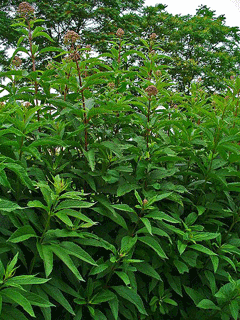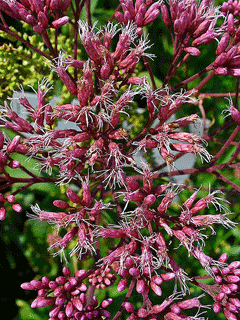 |
|
http://commons.wikimedia.org/wiki/User:Llez |
 |
| http://commons.wikimedia.org/wiki/User:LlezErysimum capitatum |
Translate this page:
Summary
Bloom Color: Purple, White.
Main Bloom Time: Early fall, Late summer. Form: Upright or erect.
Physical Characteristics

 Eupatorium purpureum is a PERENNIAL growing to 2 m (6ft) by 1 m (3ft 3in) at a fast rate.
Eupatorium purpureum is a PERENNIAL growing to 2 m (6ft) by 1 m (3ft 3in) at a fast rate.
See above for USDA hardiness. It is hardy to UK zone 4. It is in flower from August to October, and the seeds ripen from September to November. The species is hermaphrodite (has both male and female organs) and is pollinated by Insects. The plant is self-fertile.
It is noted for attracting wildlife.
Suitable for: light (sandy), medium (loamy) and heavy (clay) soils and prefers well-drained soil. Suitable pH: mildly acid, neutral and basic (mildly alkaline) soils. It can grow in semi-shade (light woodland) or no shade. It prefers moist soil.
UK Hardiness Map
US Hardiness Map
Synonyms
Plant Habitats
Woodland Garden Dappled Shade; Shady Edge; Meadow;
Edible Uses
Edible Parts:
Edible Uses: Salt
The roots have been burnt and their ashes used as salt to flavour foods[257].
References More on Edible Uses
Medicinal Uses
Plants For A Future can not take any responsibility for any adverse effects from the use of plants. Always seek advice from a professional before using a plant medicinally.
Astringent Diuretic Nervine Tonic Urinary
Gravel root was used by the native N. American Indians as a diaphoretic to induce perspiration and break a fever. The plant was quickly adopted by the white settlers and still finds a use in modern herbalism[268]. The whole plant, but especially the root, is astringent, diuretic, nervine and tonic[4, 21, 165]. It works particularly on the genito-urinary system and the uterus[238]. Especially valuable as a diuretic and stimulant, as well as an astringent tonic[4], a tea made from the roots and leaves has been used to eliminate stones from the urinary tract, to treat urinary incontinence in children, cystitis, urethritis, impotence etc[222, 254, 268]. It is also said to be helpful in treating rheumatism and gout by increasing the removal of waste from the kidneys[254, 257]. The leaves and flowering stems are harvested in the summer before the buds open and are dried for later use. The roots are harvested in the autumn and dried for later use[238].
References More on Medicinal Uses
The Bookshop: Edible Plant Books
Our Latest books on Perennial Plants For Food Forests and Permaculture Gardens in paperback or digital formats.

Edible Tropical Plants
Food Forest Plants for Hotter Conditions: 250+ Plants For Tropical Food Forests & Permaculture Gardens.
More

Edible Temperate Plants
Plants for Your Food Forest: 500 Plants for Temperate Food Forests & Permaculture Gardens.
More

More Books
PFAF have eight books available in paperback and digital formats. Browse the shop for more information.
Shop Now
Other Uses
References More on Other Uses
Cultivation details
Landscape Uses:Border, Massing, Specimen, Woodland garden. Succeeds in ordinary garden soil that is well-drained but moisture retentive in sun or part shade[200]. Plants can be grown in quite coarse grass, which can be cut annually in the autumn[233]. A very cold-hardy plant, tolerating temperatures down to about -25°c[187]. The bruised leaves have a vanilla-like odour[213]. Plants seem to be immune to the predations of rabbits[233]. Butterflies are attracted to this plant[187]. Special Features:North American native, Fragrant foliage, Naturalizing, Wetlands plant, Attracts butterflies, Suitable for cut flowers. In garden design, as well as the above-ground architecture of a plant, root structure considerations help in choosing plants that work together for their optimal soil requirements including nutrients and water. The root pattern is clumping, giving the plant a clumping habit. The predictable growth behaviour makes it easier to maintain without having to apply containment methods[2-1].
References Carbon Farming Information and Carbon Sequestration Information
Temperature Converter
Type a value in the Celsius field to convert the value to Fahrenheit:
Fahrenheit:
The PFAF Bookshop
Plants For A Future have a number of books available in paperback and digital form. Book titles include Edible Plants, Edible Perennials, Edible Trees,Edible Shrubs, Woodland Gardening, and Temperate Food Forest Plants. Our new book is Food Forest Plants For Hotter Conditions (Tropical and Sub-Tropical).
Shop Now
Plant Propagation
Seed - sow spring in a cold frame and only just cover the seed. Prick out the seedlings into individual pots when they are large enough to handle and plant them out into their permanent positions in the summer. Division in spring or autumn[111]. Very easy, the clumps can be replanted direct into their permanent positions.
Other Names
If available other names are mentioned here
Joe Pye weed
Native Range
NORTHERN AMERICA: Canada (Ontario), United States (Connecticut, Indiana, Massachusetts, Michigan (south), New Hampshire (southwest), New Jersey, New York, Ohio, Pennsylvania, Rhode Island, Vermont (south), West Virginia, Illinois, Iowa, Kansas (east), Minnesota (southeast), Missouri, Nebraska (east), Oklahoma (east), Wisconsin, Alabama (north), Arkansas, Delaware, Florida (northwest), Georgia, Kentucky, Louisiana (north), Maryland, Mississippi (north), North Carolina, South Carolina, Tennessee, Virginia)
Weed Potential
Right plant wrong place. We are currently updating this section.
Please note that a plant may be invasive in one area but may not in your area so it's worth checking.
Conservation Status
IUCN Red List of Threatened Plants Status :

Growth: S = slow M = medium F = fast. Soil: L = light (sandy) M = medium H = heavy (clay). pH: A = acid N = neutral B = basic (alkaline). Shade: F = full shade S = semi-shade N = no shade. Moisture: D = dry M = Moist We = wet Wa = water.
Now available:
Food Forest Plants for Mediterranean Conditions
350+ Perennial Plants For Mediterranean and Drier Food Forests and Permaculture Gardens.
[Paperback and eBook]
This is the third in Plants For A Future's series of plant guides for food forests tailored to
specific climate zones. Following volumes on temperate and tropical ecosystems, this book focuses
on species suited to Mediterranean conditions—regions with hot, dry summers and cool, wet winters,
often facing the added challenge of climate change.
Read More
Expert comment
Author
L.
Botanical References
43200
Links / References
For a list of references used on this page please go here
Readers comment
© 2010, Plants For A Future. Plants For A Future is a charitable company limited by guarantee, registered in England and Wales. Charity No. 1057719, Company No. 3204567.